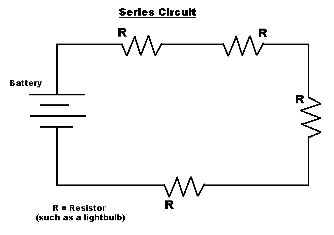Parallel Circuits vs. Series Circuits
Series vs. Parallel
The Main Idea
On this page, Parallel Circuits and Series circuits will be explained in detail and examples will be demonstrated to make sure the correct for is used at the correct time. Series and Parallel Circuits are used in so many different items. From T.V. remotes to cell phones and cars to airplanes, parallel and series circuits are the backbone of most common items that run on disposable batteries.
Which is More Common?
Parallel circuits are definitely more common than series circuits, they provide so many different types of electrical objects with their circuits that series would not be appropriate for. Series circuits are more powerful, but can really cause problems if something goes wrong, but parallel circuits are safer, and more efficient.
Series Circuits
A series circuit involves a circuit in which the components are placed in succession to one another. To put it more simply, the wires or conductors that would run through the circuit do not branch off in any way shape or form. Each lead to each battery is connected to another straight away, without having all of the batteries touch one another. Of course these circuits can have other components such as resistors, switches, any auxiliary component and a power source, or multiple. A series Circuit is the most simple form of a circuit. They are used in most everyday electronics, from the most basic to the most complex! Parallel circuits can even be simplified into series circuits.
Parallel Circuits
Much like the series circuit, the parallel circuit runs a current through more than one load. The difference is, the parallel circuit gives the current more than just one path to run around the circuit from start to finish. In a series circuit, one path is clearly defined while in parallel charges can move through different paths to find the end. The Current will depend on the resistors in the circuit.
A Mathematical Model
To find the currents in these different types of circuits there are two main equations to determining them.
Series
This is the equation for finding the current in a series circuit. Since there is only one path, the resistance can simply be added up in the denominator for one equation.
![]()
Parallel
Since there is now more than one path for the current to travel through, the resistance must be added up individually, then take the reciprocal, to find the current in the circuit.
![]()
Example
For Examples on how to do calculations on both parallel and series circuits please see: Parallel Circuits or Series Circuits
Connectedness
Circuits, whether they are parallel, series, or even RC can be seen all over the world. Everyday we use circuits, whether we are the switch on a touchscreen, or turning on a light switch on the wall, to turning the key to start your car. As for saying which circuit is better than the other, parallel and series circuits are used in very different ways, it totally depends on what you are trying to accomplish with the circuit. One advantage of a parallel circuit is that you can disconnect take a component out of the circuit without cutting the current to the rest of the circuit, such as removing a resistor or battery, you can no do this in a series circuit, as it would break the current flow.
A possible minor advantage of a series circuit is that it takes less wire to connect the same number of components in series than it does to connect them in parallel. In more complex contexts, components in AC circuits may serve different purposes depending on whether they are in parallel or series with the load part of the circuit. A good example of this is high pass vs. low pass filters. In a high pass filter a capacitor might be placed in series with a load, whereas when serving as a low pass filter the same capacitor might have been placed in parallel with the load.
For example: say your house was to be wired in series. This would mean that if you wanted to use some form of electricity, the whole house would have to be turned on at the same time. Hairdryers, Computers, washing machines, TVs, ovens and so on. With parallel circuits, which is what houses are wired in, you can turn off and turn on different items as you please, without having to turn on every item in your house.
One of the best examples of how these circuit layouts are different is Christmas tree lights. If you were to have a light strand wired in series, if one light went out, they all went out, and you would be left trying to find which light was the culprit. If they were in parallel, however, only the faulty light would go out.
Series circuits are best for simple objects. In my experience I spent a lot of time as a kid building and racing remote control vehicles. Originally, most of the cars and trucks came standard with a parallel wiring system, which was great for battery life, but down on power. I used to build Series circuit adapters to wire the batteries with and sell them at events my Dad and I used to go to. I thought they were a hit! Then the major company started selling their own and I was quickly pushed out of contention ( hard to beat OEM parts).
History
These two circuits have been around a long time, the first electric circuit was invented by Alessandro Volta in 1800. It used salt baths and conducting metal strips to conduct electricity. Soon after, more and more scientists began to play around with different types of layouts for the circuits and eventually, they stumbled into discovering the two.
See also
Parallel Circuits, Series Circuits,
References
https://thescienceclassroom.wikispaces.com/Electric+Circuits#Electric Circuits-Series and Parallel Circuits-The Series Circuit

